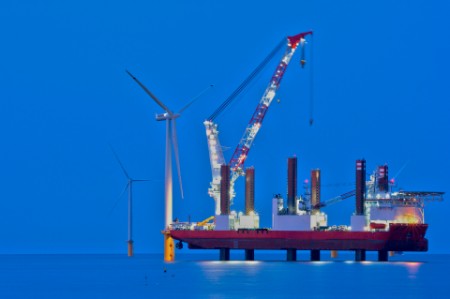
Chapter 1
The current model – and its challenges
Spanish utility and developer Iberdrola illustrates the scale of the challenge.
Iberdrola plans to invest €13bn (US$2.1bn) in renewable energy by 2022, and its £1.63bn (US$14.6bn) sale of 40% of its 714MW East Anglia offshore project to Macquarie’s Green Investment Group is just the latest example of how it is bringing in long-term investment to enable it to recycle its own capital.
There are disadvantages to this approach though
Each of these transactions results in millions of euros on costs – for the utility and the investors they bring into each deal. This places a burden on utilities in terms of managing multiple shareholder relationships and, because the assets very often remain on their balance sheets, an increasing strain on credit ratings and demand for capital elsewhere in the group.
The process is inefficient for institutional investors, too
Some big pension funds are developing the capacity in-house to make and manage infrastructure investments, including in renewable energy, but for most, exposure to this asset class is obtained through third-party infrastructure funds, introducing a layer of cost.
Incumbent utilities are faced with an urgent need to be as agile as possible.
Alternatively, they can invest directly in the equity or debt of the utility itself, but that brings other risks – namely, an exposure to other elements of the utility business model, such as retail marketing operations, legacy fossil-fuel assets, or efforts to diversify into new markets, such as energy services or electric vehicles.
Brendon Moran, Senior Banker for Energy & Utilities at French bank Société Générale (Socgen), notes that the utilities sector is at a crossroads with respect to the energy transition and needs to adapt its approach.
“Incumbent utilities are faced with an urgent need to be as agile as possible,” he says.
“The energy transition is demanding they compete across a much wider range of often contending pressures – a changing energy mix towards renewables, the rapid change in mobility and the rise of electric vehicles, and the need for innovation in energy efficiency. Focusing on their strengths and partnering with others in new ways will demand a break from the past approach of doing it all.”
Moran adds: “Some utilities are now recognising that it may not make sense to pursue the old models of vertical integration but, instead, to segment their business and focus on what they do best.”

Chapter 2
Rethinking the yieldco
Yieldcos could be another way to raise the finance utilities will need to build renewables portfolios.
First developed in the UK, the model involves creating a publicly-listed entity, run by a fund manager, that would invest in a number of typically small-scale renewable energy projects, which – at the time – enjoyed guaranteed revenues through feed-in tariffs or similar subsidies.
“It’s a relatively simple model… and a very efficient one,” says James Armstrong, Managing Partner at Bluefield Partners, which listed one of the first yieldcos, the Bluefield Solar Income Fund, with a net asset value of £436mn (US$561.7mn) as of June 2019. Yieldcos such as Bluefield pay dividends to investors, promising stable, long-term returns.
Yieldcos could offer an alternative approach to raising the finance utilities will need to build out their renewables portfolio.
Developers such as SunEdison used yieldcos to raise large volumes of debt and fund aggressive expansion strategies. Their returns were based on aggressive capital growth as well as the yields generated by projects, and initially performed strongly.
According to data from Bloomberg, around US $8bn was channelled into yieldcos in 2015, at the height of their popularity when rising share prices – providing capital growth in addition to dividend yields – fuelled investor enthusiasm.
This flood of capital depressed investor expectations of future growth, however, while their returns proved to be more correlated with oil prices than expected. Inflows became outflows, leading to some high-profile failures – of pioneer SunEdison and Spanish construction firm Abengoa’s US arm, both brought down in 2015 by aggressive debt-fuelled growth enabled by yieldcos.

Chapter 3
Why private yieldcos would work
While losses dented investor demand for yieldcos, the structure is coming back into favour.
In September 2019, Goldman Sachs announced that it had raised US$1.9bn into Goldman Sachs Renewable Power LLC, a private yieldco, while, in January 2019, Investec became a cornerstone investor in an Africa-focus yieldco, Revego Africa Energy, alongside the UK government-funded UK Climate Investments, managed by Macquarie’s Green Investment Group.
Warren, at EY, suggests that a reinvention of the yieldco could offer a more efficient way for utilities to hive off and fund renewable energy assets. “An evolution of the yieldco structure could provide a route to long-dated capital that is cost-effective and supports them to grow their asset base uninhibited by their balance sheets,” he says.
It plays to utilities’ strengths to be asset operators, offtakers and traders, but not necessarily asset owners.
The way the model works, basically, is that the utility would develop renewables projects and, once sufficiently derisked, sell them to an arms-length private yieldco, probably majority owned by a third-party investor or investors. The utility would maintain an ownership stake in the yieldco and provide asset management and operational services to the vehicle, creating an alignment of interest between the investors and the utility as the promoter. The projects themselves may well enter into PPAs with the utility promoter.
Moran, at Socgen, notes that such an approach is essentially mirroring what already happens in oil and gas. There, the large incumbents, such as the oil majors, partner with more agile, upstream exploration and production companies, engineering firms, and other parties such as governments. The oil majors bring balance-sheet strength and, most importantly, offtake demand for the oil produced.
Warren, EY Global Power & Utilities Corporate Finance Leader, says “It plays to utilities’ strengths to be asset operators, offtakers and traders, but not necessarily asset owners.”
These vehicles effectively provide a “shadow balance sheet” to which utilities could transfer assets and protect their credit ratings, while offering efficient, sustainable and replicable investment platforms.
Every single participant is re-evaluating how they engage with the market, and all financing options need to be on the table.
For institutional investors, such vehicles give them exposure directly to the infrastructure that utility companies own, rather than also investing in corporate equity or debt and taking other business risks.
By giving investors the opportunity to isolate one part of the existing utility business model, these yieldcos could help incumbents and their investors navigate the low-carbon transition.
“There is a debate going on among the big utilities as to whether they want to be generators or operators, and how to best use their capital in what is a very fast-moving transition,” notes Armstrong, Managing Partner at Bluefield Partners.
“Every single participant is re-evaluating how they engage with the market, and all financing options need to be on the table,” he says.

Chapter 4
The pros and cons
The yieldco proposal, however, is not without its drawbacks.
Marc Groves-Raines, Head of Renewable Energy for Allianz Capital Partners, one of Allianz Group’s asset managers for alternative equity investments, which owns €4.3bn (US$4.78bn) of renewable energy equity assets, says: “I can see the theory, but there may be issues applying it in practice.”
For example, questions over transfer pricing, the value ascribed to a renewable energy asset when it is sold by the utility to the yieldco. “Utilities will want to sell their assets at market value, which is why they are running the strategy they are– that is, targeted competitive processes,” says Groves-Raines. “They want to maximise the value they can squeeze out of the projects, to recycle capital while retaining operational control.”
“Investors would want reasonable scrutiny of how their money is invested and, if you’re simply putting it into a yieldco, that could dilute that scrutiny,” he adds.
“As an investor, you’re one step further removed from the project. You’re purely reliant on the dividends coming through, and you have very little broader control or security – it’s more akin to a pure, subordinated hold-co financing,” says Stephen Jennings, Head of Energy and Natural Resources for EMEA at Japanese financial services group Mitsubishi UFJ Financial Group (MUFG). “It might suit some investors, but not others. Some institutional investors might struggle with their internal ratings models on that basis, whereas they might find it easier lending directly to a sponsor, albeit as very much a minority interest.”
With such an enormous need for capital for renewables projects, numerous investment models will emerge and evolve over time.
“Given the size and scale of investment, many different forms of financing are going to be required, particularly as we move to an environment where there’s less subsidy support,” says Jennings. “The credit profile of transactions will change and investment-grade ratings are going to be less achievable. The market will have to be more innovative to react to the volumes we’re likely to see coming through and find new ways of churning capital to allow investors and banks to reinvest in new projects.”
“With such an enormous need for capital for renewables projects, numerous investment models will emerge and evolve over time,” says Warren, at EY.
“Of course, the question of which structures to employ and where to source the capital will always be pertinent, and these are not without complexity.” For example, the risk inherent in a particular structure, the depth of liquidity for a certain pool of capital, and the pricing of that capital will have a huge impact on an asset’s value.
“In addition, factors such as commercial, legal and tax structuring, accounting treatment, and the impact of credit ratings and currencies, to name a few, all have a critical part to play,” Warren adds. “There is plenty for utilities and investors to consider, not least in an unsubsidised future, where calculating the very value of a kilowatt hour is becoming increasingly complex.”
Summary
The decarbonisation of utilities’ power-generation fleet involves them recycling large volumes of capital to invest in renewables projects. But different approaches, involving new financial structures, could prove more efficient.


